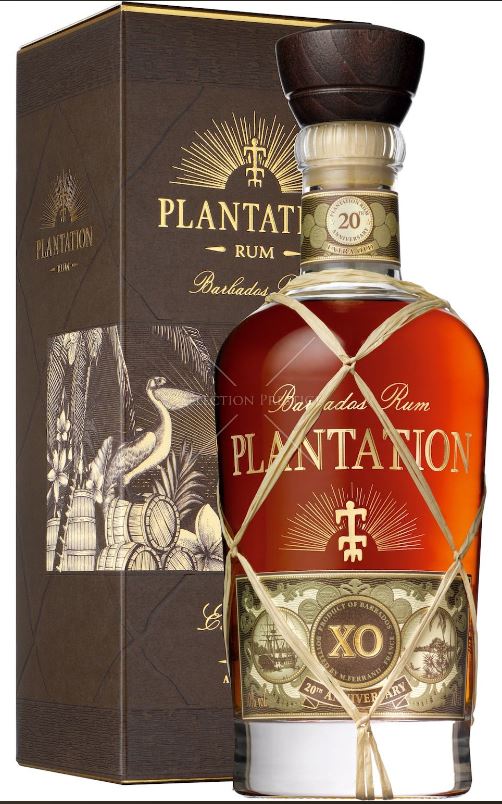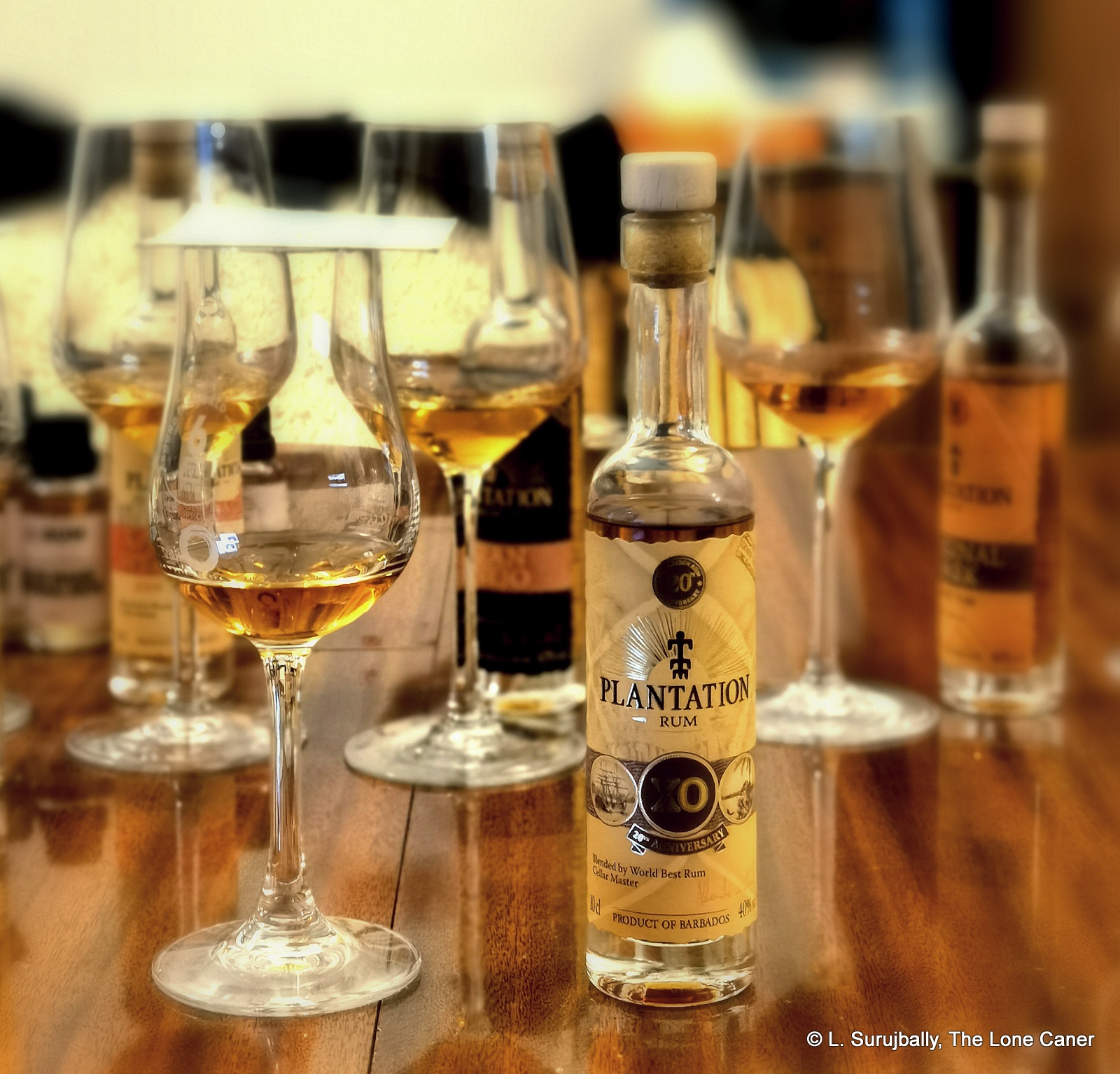It’s an old saw that time grants experience at the expense of youth, and indeed the entire review of the El Dorado 21 YO rum was an extended meditation on this theme. But perhaps, had I wanted to illustrate the issue more fully, it would have been better to reflect on the descent of the Barbados 20th Anniversary XO in my estimation over the intervening years since I first tried and wrote about it in 2012. Back then I awarded it what by contemporary standards is an unbelievable 88.5 points and my opening blurb naming it “one of the top sipping rums of my 2012 experience” can in no way be repeated a decade later without causing howls of disbelieving and derisive laughter from all and sundry, and a recent re-tasting of the rum shows why this is the case.
The rum’s nose opens with a light, medicinal sort of aroma reminiscent of quinine, except that it’s sweet and not sharp at all. It develops into hints of honey, caramel, blancmange and soft ripe fruits – flambeed bananas, raisins, apples on the edge of spoiling – that combine into a softly congealed sweetness that hides the sharpness one suspects may be lurking beneath it all. There are marshmallows, coconut milk, sweet pastries with a surfeit of icing sugar, but little acid bite or edge that would balance this all off. It’s a heavy dull, sweet nose, covering the senses like a wet blanket.
The deepening disappointment I feel about the rum has nothing really to do with the War of the Barbados GI (as I’ve heard it described), or the choice of Plantation as a brand name (with all its subsequent negative connotations), or some of the questionable business practices of the company. Those matters have been discussed and dissected at length and will continue to raise blood pressures for years to come. It doesn’t even have anything to do with Ferrand’s careful marketing, problematic labelling and the cold-eyed sales strategy, none of which, after all, is personal – it’s just business. But all these dodgy issues aside, the fact remains that if ever there was a poster child for how tastes evolve and how what was once a real favourite can turn into a symbol of so much that no longer works, this rum is it.
On the palate, the initial sensations suggest all is well. The tastes are nicely fruity: sugar cane sap, vanilla, coconuts shavings, white chocolate, giving one the impression of a liquid Ferrero Raffaello Confetteria (but not as good). And yet, all the fruits striding forward to centre stage are too ripe, here – yellow mangoes, peaches, apricots, cherries. Thickly sweet tastes overwhelm the sharper rummy notes of caramel and light molasses with a barrage of marshmallows, candy floss and sugar water and blattens everything flat.
That profile as described might surprise many emergent rum fans from America in particular. After all, if one were to consult those three great repositories of crowdsourced rum opinion – Reddit’s /r/rum, Rum Ratings and Rum-X – the vast majority of the respondents just love this thing, as the high consolidated scores on those platforms attest (the last one is the lowest with a 79 point average from 414 ratings).
 And on the surface, there’s no question that it presses many of the right buttons: it’s been widely available (since 2007) at a slightly-higher-than-cheap price, has got that faux-ultra-premium bottle and gold etching; and it’s not part of the “standard backbar line” of the 3-Star, OFTD or Original Dark but one level higher (the “Signature Blends”). It remains bottled at 40% ABV and continues to be touted as being a blend of “quintessential extra-old rums from Barbados”. The company website provides disclosure: the various ages of the blend, the pot/column still makeup, the dual-ageing regimen, and of particular note is the 20g/L “dosage” element, which is considered to be the sugaring that makes it sweet (it’s not, really, but serves as a useful shorthand). So all that provision and declaration and presentation, and it’s all good, right?
And on the surface, there’s no question that it presses many of the right buttons: it’s been widely available (since 2007) at a slightly-higher-than-cheap price, has got that faux-ultra-premium bottle and gold etching; and it’s not part of the “standard backbar line” of the 3-Star, OFTD or Original Dark but one level higher (the “Signature Blends”). It remains bottled at 40% ABV and continues to be touted as being a blend of “quintessential extra-old rums from Barbados”. The company website provides disclosure: the various ages of the blend, the pot/column still makeup, the dual-ageing regimen, and of particular note is the 20g/L “dosage” element, which is considered to be the sugaring that makes it sweet (it’s not, really, but serves as a useful shorthand). So all that provision and declaration and presentation, and it’s all good, right?
The finish is smothering, though light, and thankfully escapes the kiss-of-death word “cloying”. There’s stuff going on here and it’s delicious: caramel, honey, brown sugar, vanilla, raisins, honey and even some tamarind, but there’s not enough of it, and what is sensed remains covered over by a sort of placid languor, a dampening effect of the sweetening that provides a sweet and warm conclusion, just not a memorable one.
Not entirely. For all its current disclosure, Plantation sure wasn’t talking any more than anyone else, back in 2012 and it was only after 2014 that they started to come up to scratch (trust me, I was there). That’s when they and many (but not all) others belatedly came out of the closet in a come-to-Jesus-moment and said “Yeah, but we always did it this way, it’s been a long standing practice, and it makes the rum better.”1.
What’s often not addressed in the denunciations of dosage is exactly why the sugaring was and remains considered such a bad thing, so here’s a recap. A common refrain is that it destroys the purity of rum, the way spicing does, so one is not getting an original experience – and worse, one may be paying a higher price for a cheap rum cunningly dosed to make it seem more premium. Secondly there’s a lesser but no less important point of reasons related to fitness and health. But those matters aside, it really is because rum chums hate being lied to: the practice was never disclosed by any producer, while being fiercely denied the whole time. These and other social issues surrounding the parent company go a long way to explaining the despite the rum gets, though at end, much of this is window dressing, and it’s how the rum works (or not), and perhaps how it’s classified, that’s the key issue, since disclosure is now provided. Other than that, the matters above don’t — or shouldn’t — impact on any evaluation of the rum at all (though no doubt many will disagree with me on this one).
By that exacting, laser-focused and narrow-bore standard, then, all the markers suggest a rum with luscious potential…but one which doesn’t deliver. It is really too faint to be taken seriously and too sweet to showcase real complexity — although this is precisely what many new entrants to rum, weaned on Captain Morgan, cheap Bacardis, Kraken, Bumbu or Don Papa, consider smooth, sippable and top end. As with earlier El Dorado rums, nowadays for me the real question is not the dosage per se (after all, I can simply chose not to drop my coin on the rum) just why it continues, since it is really quite unnecessary. The rum is discernibly fine and can be better with less additions, or no sweetening at all; and I think that the state of the rumiverse generally is now sufficiently educated and aware – in a way we were not back in the early 2000s – for it to be re-released as an adulterated / spiced rum or reissued without the dosage as something more serious…rather than pandering the way it does and having the best of both worlds.
That might make me a purist…but I chose to believe it’s more that I don’t think that a rum that’s already intrinsically decent needs to have such embellishment, which we never asked for, no longer need and really no longer want. It cheapens the whole category and lessens any kind of serious consideration of the spirit as a whole
All that, and it really is just too damned sweet.
(#904)(76/100) ⭐⭐⭐
Other notes
- My hydrometer tested this out at 35.07% ABV, which works out to just about 20g/L so the website is spot on. This is a reduction from the decanter version I had originally reviewed a decade ago.
- In this retrospective, I have deliberately chosen not to go deeper into the theme of “separating the artist from the art”, as that is a subject requiring a much more nuanced and opiniated exploration. It is, however, on my radar, and not only for this company.
- What exactly the “20th Anniversary” is, remains debated. Some say it’s of Mr. Gabriel’s becoming a master blender, others have differering opinions. It’s not the age of the rum, though, which is a blend of 8-15 YO distillates. It may of course be simply a number put there for marketing reasons, or something of significance to Maison Ferrand.
Footnotes
- It says a lot for the innocence of that time, back before Johnny Drejer came along and upset the applecart in 2014 with the first hydrometer lists, that just about all the initial reviews of this thing were positive. It was amusing to observe the huffy silence — or to watch the exculpatory scramble for the exits — by the same reviewers who gave such ecstatic hosannas in the early years.

Tastes do indeed change with age. This was brought home to me recently when I realised I no longer had much interest in rum or bourbon. All I wanted to drink was whisk(e)y. And this after 30 years of enjoying and sampling countless rums and bourbons and gins.
I’ve no idea how a reviewer (or show judge) can compensate for changes in personal taste like this.
The only way I ever found to compensate, was to re-review rums I’ve already tried and written about and be clear about what changed and how the evalusation was no longer the same. Usually the cost is too prohibitive to do so on a systematic basis, though, so I am relegated to the occasional post like this one.
Any reviewer who is at this for a few years should be honest enough to acknowledge the change in poreferences and tastes over time. To not do so implies one’s tastes remain static forever, and that’s simply not credible.